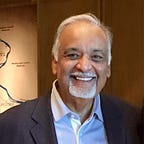Building Organizational Strength By Hiring To Its Weakness
Let’s Hire Someone Who Is Not Just Like Us!
When hiring a new employee, we often tend to choose someone with whom we feel most comfortable. This usually translates into hiring someone similar to us. Similar in race, gender, experiences? Quite possibly. Often, it is someone who is just like us!
This is predictable normal human behavior, but it may be less than optimal for creating a strong organization.
I had the privilege of leading multiple change initiatives at a major corporation. Over the years, we developed a simple model that has been effective for us.
Psychologists and organizational behavior specialists have developed many different models for building high-potential teams. These models are often complex requiring experts and external consultants to evaluate, analyze and implement.
Model: Our model is based on a simple premise: every successful organization needs four different skill sets —
- Visionary
- Strategist
- Tactician
- Implementer
Normally every individual has a mix of these four skills, with one or two of the skills being dominant. If a team or an organization recognizes the need to strengthen the missing skills — and consciously addresses them — it will be more successful. These skills are like the links of a chain: we need all of them to be strong.
Discovery: How did we discover this model? During a company reorganization, we eliminated an entire layer of management at the divisional level to create a flatter organization. Our consultants and organizational behavior experts strongly recommended the new, flatter structure.
What none of us realized was that certain skill sets had been developed at each level of the old organization over the previous four decades:
- Vision: corporate level
- Strategy: company level
- Tactical decisions: functional and business leaders
- Implementation: the programs, projects and the people.
We discovered that each level provided an essential skill set.
Analogy: The following analogy may help explain the need for these four skill sets.
Think of a ship leaving New York. The captain says, “Head for London.” That is her vision. The navigation officer pulls out his charts and checks the weather forecasts and typical currents. Instead of drawing a straight line from New York to London, he plots a route (strategy) that takes into account the known hazards. He aims to ensure passenger safety and comfort without compromising the schedule or the captain’s vision.
Once under way, the watch officer (tactician) makes sure that the ship stays on course. She periodically checks the ship’s position and advises the helmsman when to correct the course, not by going straight back to the original route, but by making a tactical correction. The helmsman (implementer) steers the ship to the tactical course, which is a subset of the strategic course, which fulfills the vision.
Self Evaluation: So how does this apply to hiring employees in a corporate environment? First, we must be honest with ourselves. What are our strengths and weaknesses? What are we really good at and what do we avoid doing? We cannot excel at everything! Divorces and burnouts in the executive ranks provide exemplary evidence.
Execution: The best strategic thinker I have run across in more than 30 years of industry experience was one of our program managers. As his deputy, I became a good tactician. This allowed us to exceed the customer’s vision and expectations with implementation by our organization’s superb employees.
Later in my career when I worked with a new boss, I discovered that her strengths were different. She was a world-class visionary and a true “evangelist” for change. She was also an amazing implementer and could quickly improve any process in days if not hours.
The best way to ensure that we could work well together was for me to identify her strengths and then complement them with my strengths. So I focused on strategies and tactics. A year later, she was promoted. And soon after, I too was promoted.
Recommendation: There is power in honest recognition of our strengths and weaknesses — and strengthening our weaknesses leverages that power.
When charting new paths, we need to evaluate our strengths, admit our weaknesses and hire someone whose biggest strength is our weakest skill.
Let’s strengthen our organization and hire someone who is not just like us.
***********************************
S. K. Gupta is a former senior executive of a Fortune 50 corporation. He enjoys researching and writing about the not-so-obvious things in life. Feedback welcome. sk.gupta.us@gmail.com.
